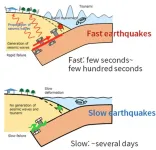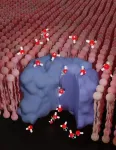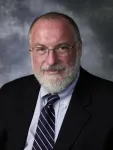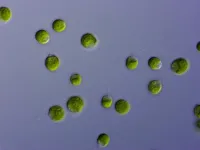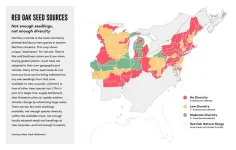(Press-News.org) For years, we’ve known that a special kind of molecular assembly known as a “polyelectrolyte complex” helps your cells keep themselves organized. These complexes are very good at forming interfaces to keep two liquids separated: your cells use them to create compartments. These abilities have led scientists to consider them for technological applications, including filtering water, better batteries, and even underwater glue, as well as for better pharmaceutical drugs.
But for decades, no one knew exactly how the regions looked inside a polyelectrolyte complex. There are positively charged and negatively charged chains, but how do they line up? Were they arranged in neat alternating lines, or more like what a Russian scientist termed “scrambled eggs”?
A new study from the University of Chicago’s Pritzker School of Molecular Engineering has laid out the internal structure of polyelectrolyte complexes for the first time.
“Knowing the molecular structure means you can synthesize them and prepare them more precisely, which creates opportunities for applications,” said study co-author Juan de Pablo, the Liew Family Professor of Molecular Engineering and senior scientist at Argonne National Laboratory.
Simulations and scattering
A team of scientists led by de Pablo and Matt Tirrell, dean of the Pritzker School of Molecular Engineering and also a senior scientist at Argonne, undertook a years-long exploration to pin down the mystery. First, postdoctoral researchers Artem Rumyantsev (now on the faculty of North Carolina State University) and Heyi Liang developed molecular models and carried out thousands of simulations, as well as theoretical calculations based on statistical mechanics, to understand the most likely way these molecules would assemble.
Next, a group led by graduate student Yan Fang and postdoctoral researcher Angelika Neitzel (now at the University of Florida) worked to create precise versions of these molecules in the laboratory and use an advanced technique to determine their structure.
One of the few ways to see the fine details of such molecules is with a technique called neutron scattering. This is done by sending beams of neutrons—the neutral particles that make up atomic nuclei—at the molecules, and then reconstructing their patterns from the way the neutrons scatter away. But normally, the positively charged and negatively charged chains look the same when you do this.
To tell them apart, the researchers used a clever trick. Both chains have hydrogen atoms in them. But the team replaced the hydrogen atoms in the positively charged chains with a very slightly different version of hydrogen, known as deuterium, which shows up differently when the neutrons scatter off it.
Using this approach, they could see that the chains did have distinct small-scale repeating patterns, though they were not rigorously ordered over long distances.
‘A powerful combination’
The scientists explained that once you know the molecular structure for these molecules, you can think about using them for other applications. In addition to being important for understanding how our bodies and biology work, polyelectrolyte complexes’ unique abilities make them very attractive to scientists and engineers.
“These droplets still have a lot of water with them, which makes their interfacial tension low—so they tend to encapsulate objects or spread over surfaces and adhere, which are both very useful behaviors,” explained Tirrell. “You can use this to deliver drugs in the body, or for things like designing an underwater adhesive.”
Tirrell added that the study is a model for how theoretical and experimental science groups can work together: “It’s a very powerful combination of these two approaches. It wouldn’t have happened with either group working in isolation.”
END
Study reveals long-debated makeup of the molecules that help organize your cells
Structure of polyelectrolyte complexes could lead to better drugs and technology, say UChicago scientists
2023-07-31
ELSE PRESS RELEASES FROM THIS DATE:
How to distinguish slow and fast earthquakes
2023-07-31
Researchers from the University of Tokyo and Stanford University show what differentiates slow and fast earthquakes and how their magnitudes vary with time.
Normally, earthquakes last up to a few minutes and radiate strong seismic waves. But around 23 years ago, scientists discovered an unusual slow-slip phenomena called slow earthquakes. Slow earthquakes last days or even months. Though they involve significant tectonic movement, you may never feel them. Since slow earthquakes could indicate future fast earthquakes, monitoring and ...
Research shows filter tip stent retrievers may allow neurointerventionalists to remove blood clots on the first try during stroke treatment
2023-07-31
FOR IMMEDIATE RELEASE: July 31, 2023, 12:00 P.M. PDT
CONTACT: Camille Jewell
cjewell@vancomm.com or 202-248-5460
Research Shows Filter Tip Stent Retrievers May Allow Neurointerventionalists to Remove Blood Clots on the First Try During Stroke Treatment
SAN DIEGO—Research presented today at the Society of NeuroInterventional Surgery’s (SNIS) 20th Annual Meeting shows that different types of stent retriever tips may result in improved patient outcomes when performing mechanical thrombectomy to treat stroke.
Ischemic stroke, one of the most common types of strokes, happens ...
Nuclear spin's impact on biological processes uncovered
2023-07-31
A research team led by Prof. Yossi Paltiel at the Hebrew University of Jerusalem with groups from HUJI, Weizmann and IST Austria new study reveals the influence of nuclear spin on biological processes. This discovery challenges long-held assumptions and opens up exciting possibilities for advancements in biotechnology and quantum biology.
Scientists have long believed that nuclear spin had no impact on biological processes. However, recent research has shown that certain isotopes behave differently due to their nuclear spin. The team focused on stable oxygen isotopes (16O, 17O, 18O) and found ...
Researchers use geospatial mapping to assist burn patients
2023-07-31
University of Texas at Dallas researchers are using geospatial mapping techniques to identify social and environmental obstacles in communities that might impede burn injury survivors’ reentry into society.
The project is designed to help patients with burn injuries better adapt to their lives after medical discharge, including improving patient access to transportation, employment, food and other necessities.
“Our study looks at how people who survive burn injuries reenter the community,” said Dr. Richard Scotch, program head of sociology and a professor of public policy and political economy in the School of ...
Diving deep: Unveiling the secrets of microalgae to cope with environmental challenges.
2023-07-31
Environmental change, such as ocean warming, alters resource competition and biodiversity. Thus, it is essential to understand how organisms respond to increased competition because changes in their size and metabolism affect the productivity of ecosystems.
Competition has long been recognized as a driving force behind rapid evolution. Still, until now, a mechanistic framework for identifying the specific traits that evolve and their trajectories has yet to be developed. Researchers at Gulbenkian and Monash University turned to metabolic theory, which explicitly predicts how competition shapes the evolution of metabolism ...
Plans to plant billions of trees threatened by massive undersupply of seedlings
2023-07-31
The REPLANT Act provides money for the US Forest Service to plant more than a billion trees in the next nine years. The World Economic Forum aims to help plant a trillion trees around the world by 2030. Many US cities have plans to shade their streets with millions of trees. Major government and private funding is being invested in planting trees as a powerful tool to fight climate change, protect water, clean air, and cool cities. In short, trees are hot.
But new research shows a troubling bottleneck that could threaten these efforts: U.S. ...
Hollings director honored as fellow of Royal College of Physicians
2023-07-31
Raymond N. DuBois, M.D., Ph.D., director of MUSC Hollings Cancer Center, has been inducted as a fellow into the Royal College of Physicians (RCP).
DuBois traveled to London, England, for the ceremony in July. He had been elected to the prestigious body prior to the COVID pandemic, which delayed the induction ceremony.
The Royal College of Physicians was established in 1518 by a royal charter from King Henry VIII. The college's founding aim was to professionalize physicians through an academic body that required a degree and an exam before ...
NIH launches long COVID clinical trials through RECOVER Initiative, opening enrollment
2023-07-31
EMBARGOED FOR RELEASE
Monday, July 31, 2023
Noon EDT
Contact
NIH Office of Communications and Public Liaison
NIH News Media Branch
301-496-5787
NIH launches long COVID clinical trials through RECOVER Initiative, opening enrollment
Today, the National Institutes of Health launched and is opening enrollment for phase 2 clinical trials that will evaluate at least four potential treatments for long COVID, with additional clinical trials to test at least seven more treatments expected in the coming months. Treatments ...
Johnson-Matthews receives funding for conference: VL/HCC 2023 Graduate Consortium
2023-07-31
Brittany Johnson-Matthews, Assistant Professor, Computer Science, received funding from the National Science Foundation for: "Conference: VL/HCC 2023 Graduate Consortium."
This award will support the Graduate Consortium at this year's IEEE Conference on Visual Languages and Human-Centric Computing (VL/HCC), which will be held in Washington, D.C. October 2-6, 2023.
Johnson-Matthews said, "This funding will support the ability for students across the country to come together, network, share their research, and curate advice on completing their PhD from senior members of the VL/HCC community."
VL/HCC ...
Wang conducting finite temperature simulation of non-Markovian quantum dynamics
2023-07-31
Wang Conducting Finite Temperature Simulation Of Non-Markovian Quantum Dynamics
Fei Wang, Assistant Professor, Chemistry and Biochemistry, received funding from the National Science Foundation for the project: "Finite temperature simulation of non-Markovian quantum dynamics in condensed phase using quantum computers."
For this research, Wang will develop efficient quantum algorithms to perform condensed phase quantum dynamics simulations on quantum computers.
Many important physical and chemical processes occur in the condensed phase, spanning chemical reactions in solutions, charge transfer at semiconductor interfaces, ...
LAST 30 PRESS RELEASES:
Short, light-intensity exercise boosts executive function and elevates mood in children
Jeonbuk National University researchers reveal new interface engineering strategy for efficient and stable back-contact solar cells
Tyrosinase drives hydroquinone-induced exogenous ochronosis: not HGD inhibition
UMass Amherst chemists develop unique tool for studying RNA
Disappointment alters brain chemistry and behavior
A built-in odometer: new study reveals how the brain measures distance
Stress-related brain signals drive risk of cardiovascular disease in people with depression and anxiety
New details on role of fat transport molecules in Alzheimer’s onset
Study illuminates how an antiviral defense mechanism may lead to Alzheimer’s disease
Spot the males: New gene-editing method could transform mosquito control
AI learns to build simple equations for complex systems
NAU team releases 13 years of detailed U.S. CO2 emissions data
Unveiling how sodium-ion batteries can charge faster than lithium-ion ones
How do childcare tax credits affect children’s long-term health?
Can an electronic nose detect indoor mold?
Do natural disasters have long-term impacts on mortality in older adults?
Modification improves sodium‐ion batteries as an alternative to lithium-ion batteries
Parasports provide a range of benefits for people with cerebral palsy
How does grandparental care affect children’s health?
Why are there so many Nordic mediators?
Young shark species more vulnerable to extinction
Mobile fetal heart monitoring linked to fewer newborn deaths in Tanzania
Bluey’s dad offered professorial chair in archaeology at Griffith University
Beyond small data limitations: Transfer learning-enabled framework for predicting mechanical properties of aluminum matrix composites
Unveiling non-thermal catalytic origin of direct current-promoted catalysis for energy-efficient transformation of greenhouse gases to valuable chemicals
Chronic breathlessness emerging as a hidden strain on hospitals
Paleontologists find first fossil bee nests made inside fossil bones
These fossils were the perfect home for ancient baby bees
Not everyone reads the room the same. A new study examines why.
New research identifies linked energy, immune and vascular changes in ME/CFS
[Press-News.org] Study reveals long-debated makeup of the molecules that help organize your cellsStructure of polyelectrolyte complexes could lead to better drugs and technology, say UChicago scientists
